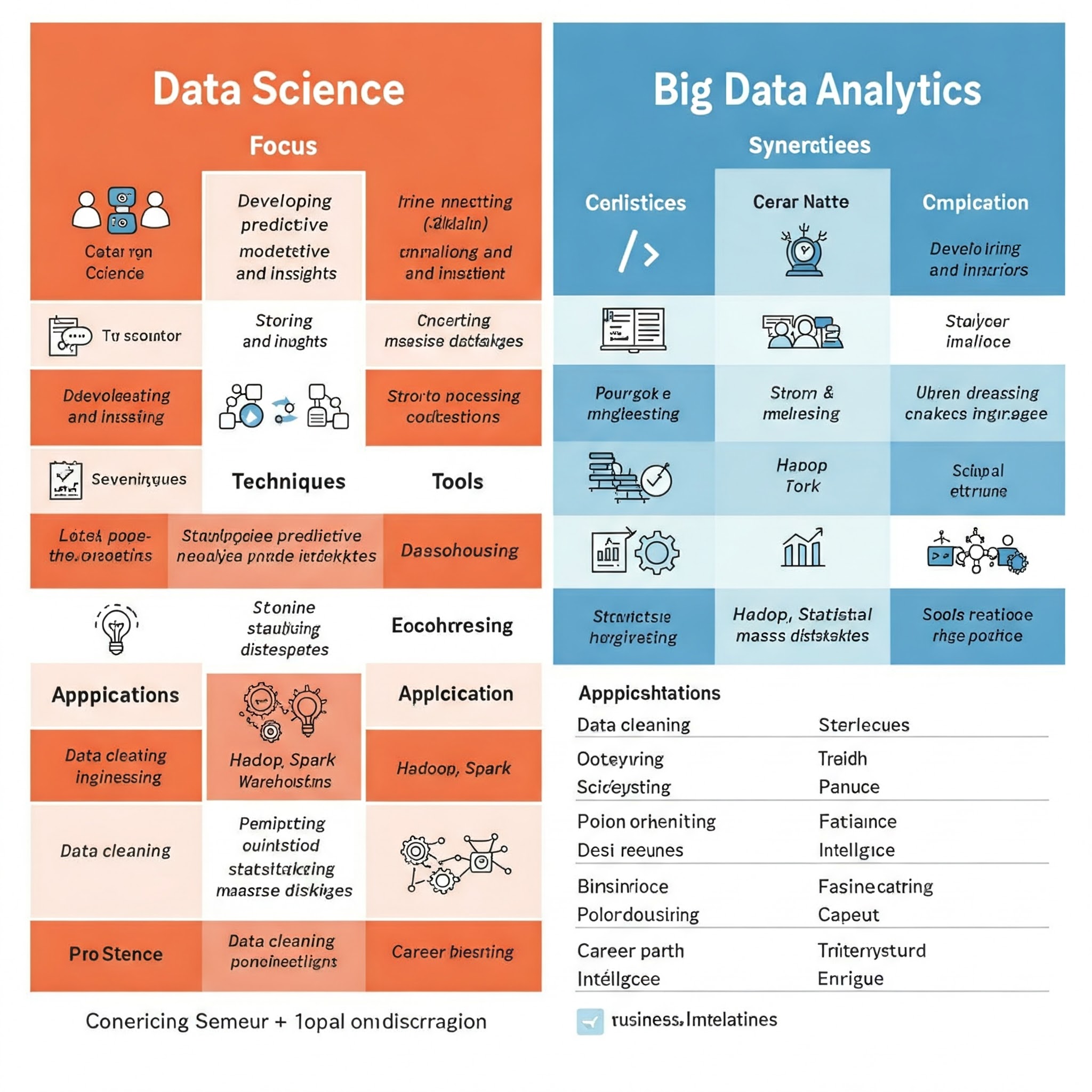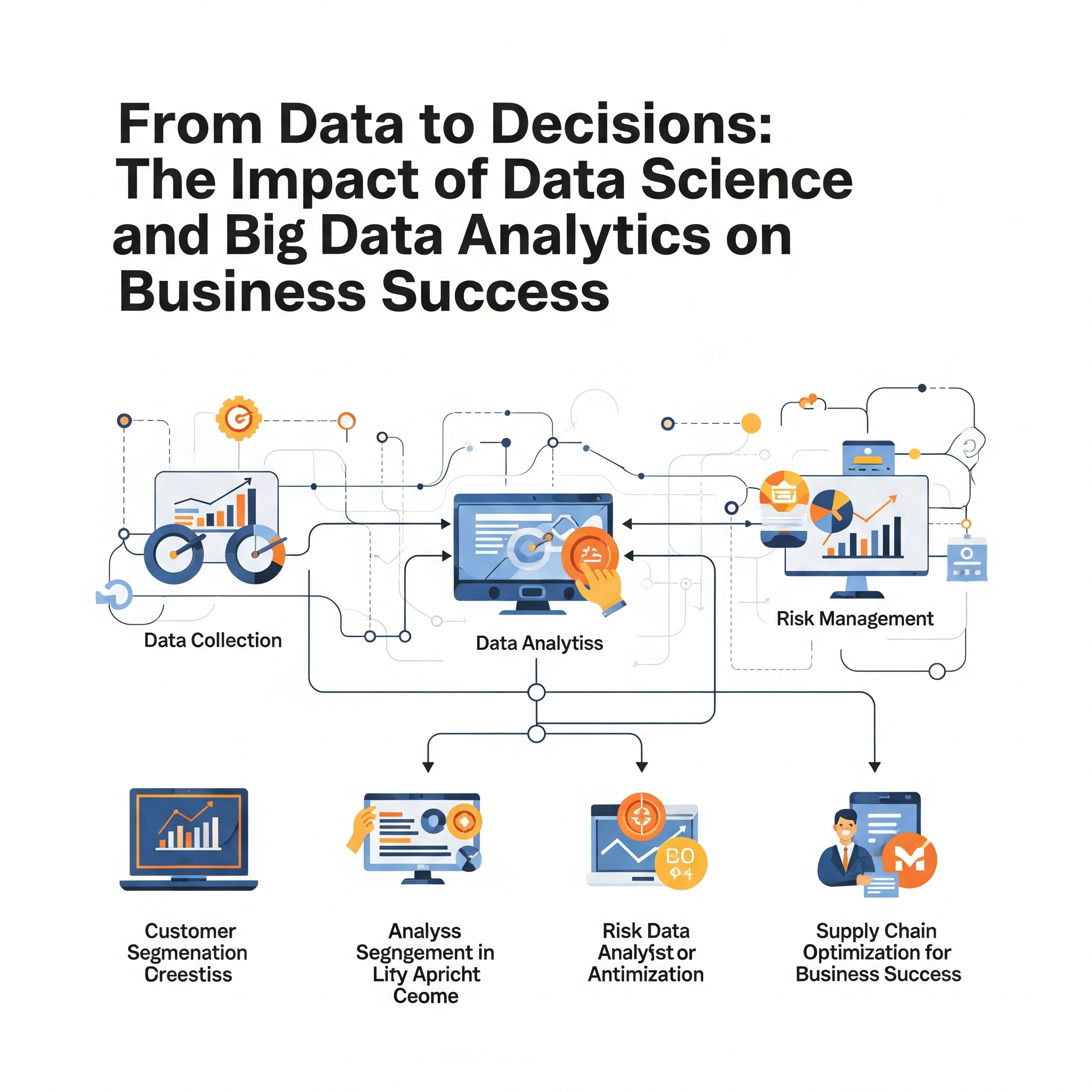The convergence of data science and big data analytics has fundamentally transformed how organizations extract value from their information assets. As we navigate through 2025, this intersection continues to evolve at breakneck speed, driven by technological advances, increasing data volumes, and the growing sophistication of analytical techniques. Understanding where these disciplines meet and how they complement each other is crucial for organizations looking to harness the full potential of their data.
The Evolving Landscape
Data science and big data analytics, while distinct in their approaches, share a symbiotic relationship that has become increasingly intertwined. Data science provides the methodological framework and statistical rigor needed to extract meaningful insights, while big data analytics offers the infrastructure and tools necessary to process vast amounts of information at scale. This convergence has created new opportunities for innovation and has fundamentally changed how businesses approach decision-making.
The modern data ecosystem is characterized by unprecedented complexity and scale. Organizations now deal with structured and unstructured data from numerous sources, including IoT devices, social media platforms, transaction systems, and sensor networks. The challenge lies not just in storing and processing this information, but in transforming it into actionable insights that drive business value.
Current Trends Shaping the Field
Real-Time Analytics and Streaming Data Processing
The demand for real-time insights has pushed the boundaries of traditional batch processing systems. Organizations are increasingly adopting streaming analytics platforms that can process and analyze data as it arrives, enabling immediate responses to changing conditions. This shift has been particularly pronounced in sectors such as finance, e-commerce, and telecommunications, where milliseconds can mean the difference between profit and loss.
Technologies like Apache Kafka, Apache Flink, and cloud-native streaming services have become essential components of modern data architectures. These platforms enable continuous processing of data streams, allowing organizations to detect anomalies, identify trends, and trigger automated responses in real-time.
Artificial Intelligence and Machine Learning Integration
The integration of AI and ML capabilities into big data analytics platforms has democratized advanced analytics. Organizations no longer need specialized data science teams to benefit from sophisticated analytical techniques. Automated machine learning platforms and AI-powered analytics tools are making it possible for business users to apply complex algorithms to their data without deep technical expertise.
This trend has been accelerated by the development of more intuitive interfaces and the automation of many traditionally manual processes, such as feature engineering, model selection, and hyperparameter tuning. The result is a more accessible and scalable approach to data science that can be deployed across entire organizations.
Edge Computing and Distributed Analytics
The proliferation of IoT devices and the need to process data closer to its source has driven the adoption of edge computing architectures. Rather than sending all data to centralized data centers, organizations are deploying analytical capabilities at the edge of their networks, enabling faster processing and reduced bandwidth requirements.
This distributed approach to analytics presents unique challenges and opportunities. While it enables real-time processing and reduces latency, it also requires new approaches to data governance, security, and model deployment. Organizations must develop strategies for managing distributed analytical workloads while maintaining consistency and reliability.
Cloud-Native Analytics Platforms
The migration to cloud-native architectures has fundamentally changed how organizations approach big data analytics. Cloud platforms offer virtually unlimited scalability, pay-as-you-go pricing models, and access to cutting-edge analytical tools without the need for significant upfront investments in infrastructure.
Serverless computing and containerized deployments have made it easier to deploy and scale analytical workloads dynamically. This flexibility allows organizations to experiment with new approaches and scale their analytics capabilities based on demand, making advanced analytics more accessible to organizations of all sizes.
Best Practices for Success
Establishing a Data-Driven Culture
The success of any data science and big data analytics initiative depends heavily on organizational culture. Companies that successfully leverage these technologies typically have cultures that value data-driven decision-making, encourage experimentation, and view failures as learning opportunities.
Creating this culture requires leadership commitment, appropriate incentives, and ongoing education. Organizations must invest in training their workforce to understand and work with data, while also ensuring that data insights are accessible and actionable for decision-makers at all levels.
Implementing Robust Data Governance
As organizations scale their analytics capabilities, data governance becomes increasingly critical. Effective governance frameworks ensure data quality, security, and compliance while enabling appropriate access to information across the organization. This includes establishing clear data ownership, implementing quality controls, and maintaining comprehensive metadata management.
Privacy and security considerations are particularly important in today’s regulatory environment. Organizations must ensure that their analytics practices comply with regulations such as GDPR, CCPA, and industry-specific requirements while still enabling valuable insights to be extracted from their data.
Designing Scalable Architecture
The architecture underlying data science and big data analytics initiatives must be designed for scale from the outset. This includes choosing appropriate storage solutions, processing frameworks, and analytical tools that can grow with the organization’s needs. Modern architectures typically embrace microservices patterns, containerization, and cloud-native technologies to ensure flexibility and scalability.
Data lakes and data warehouses serve different purposes in these architectures, and organizations must carefully consider how to structure their data storage to support both exploratory analytics and production workloads. The emergence of data mesh architectures has also introduced new approaches to organizing and governing data across distributed teams and systems.
Focusing on Business Value
While technical capabilities are important, the ultimate success of data science and big data analytics initiatives is measured by their impact on business outcomes. Organizations must maintain a clear focus on identifying and solving specific business problems rather than simply implementing the latest technologies.
This requires close collaboration between technical teams and business stakeholders to ensure that analytical efforts are aligned with strategic objectives. Regular assessment of return on investment and continuous refinement of analytical approaches based on business feedback are essential for long-term success.
Ensuring Data Quality and Reliability
The insights generated by data science and big data analytics are only as good as the underlying data. Organizations must invest in data quality management processes, including data profiling, cleansing, and validation. This is particularly challenging in big data environments where traditional data quality tools may not scale appropriately.
Implementing automated data quality checks, establishing data lineage tracking, and creating feedback loops between analytical teams and data producers are essential practices for maintaining data reliability at scale.
Emerging Technologies and Future Directions
Quantum Computing and Advanced Analytics
While still in early stages, quantum computing holds promise for solving complex optimization problems and accelerating certain types of machine learning algorithms. Organizations should begin exploring the potential applications of quantum computing in their analytics workflows, particularly for problems involving large-scale optimization or complex pattern recognition.
Federated Learning and Privacy-Preserving Analytics
The need to balance analytical capabilities with privacy concerns has led to increased interest in federated learning and other privacy-preserving techniques. These approaches enable organizations to collaborate on analytics projects without sharing sensitive data, opening new possibilities for cross-organizational insights while maintaining privacy and security.
Augmented Analytics and Natural Language Processing
The integration of natural language processing capabilities into analytics platforms is making data more accessible to non-technical users. Conversational analytics interfaces and automated insight generation are reducing the barriers to data exploration and enabling more widespread adoption of analytical capabilities across organizations.
Challenges and Considerations
Talent and Skills Gap
The rapid evolution of data science and big data analytics technologies has created a significant skills gap in the market. Organizations must invest in training their existing workforce while also competing for scarce talent in the market. This includes not only technical skills but also the ability to translate business problems into analytical solutions and communicate insights effectively to stakeholders.
Integration Complexity
As organizations adopt multiple analytics platforms and tools, integration becomes increasingly complex. Ensuring seamless data flow between systems, maintaining consistency across different analytical environments, and managing the complexity of hybrid and multi-cloud deployments requires careful planning and ongoing management.
Ethical Considerations
The power of modern analytics capabilities raises important ethical questions about bias, fairness, and transparency. Organizations must develop frameworks for ensuring that their analytical models are fair and unbiased, particularly when they impact human decisions. This includes regular auditing of models, consideration of algorithmic bias, and transparency in how analytical insights are generated and used.
Strategic Recommendations
Organizations looking to succeed at the intersection of data science and big data analytics should focus on building flexible, scalable foundations that can evolve with changing requirements. This includes investing in modern data architectures, establishing strong governance frameworks, and fostering a culture that values data-driven decision-making.
The key is to start with clear business objectives and build analytical capabilities that directly support these goals. Rather than trying to implement every new technology, organizations should focus on solutions that provide clear value and can be integrated into their existing workflows and processes.
Success in this space requires a long-term perspective and willingness to adapt as technologies and best practices continue to evolve. Organizations that can balance technical innovation with practical business requirements will be best positioned to leverage the full potential of data science and big data analytics in the years ahead.
The intersection of data science and big data analytics represents one of the most significant opportunities for organizational transformation in the modern business environment. By understanding current trends, implementing best practices, and maintaining a focus on business value, organizations can unlock the full potential of their data assets and drive sustainable competitive advantage in an increasingly data-driven world.
At 7Shades Digital, we specialised in creating strategies that help businesses excel in the digital world. If you’re ready to take your website to the next level, contact us today!





